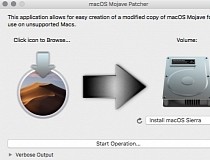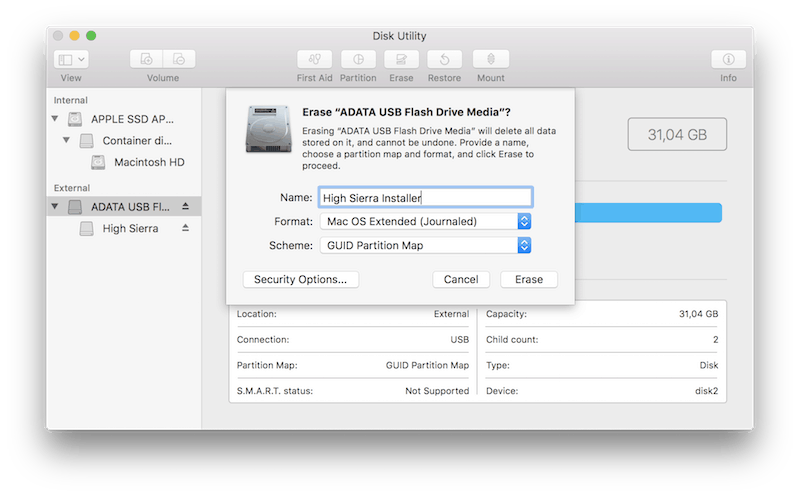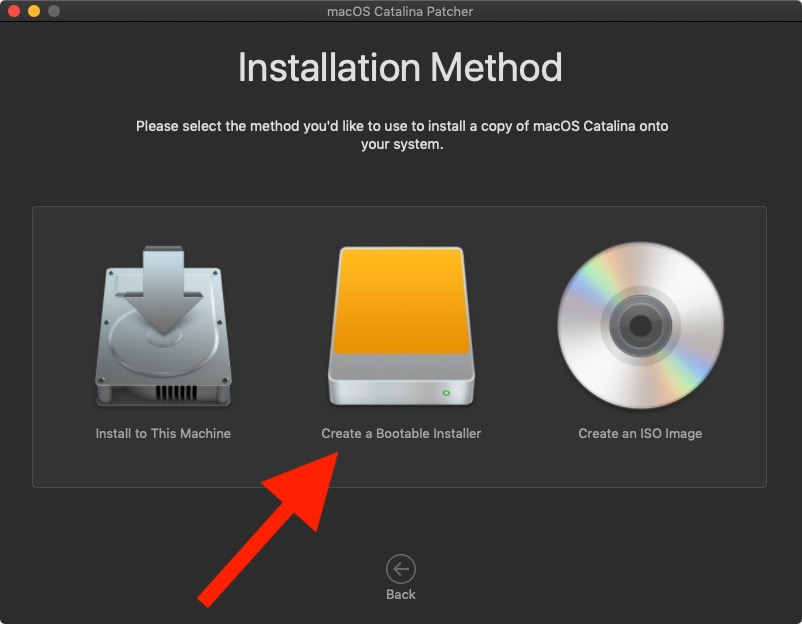Macos Sierra Patcher Tool
A $ man sh shows the manual for the sh(1) command, with a 2019 date for macOS 12.0, so it lead me to believe that a dedicated manual for macOS commands might exist out there. Though a OSX manual would be already nice as well. Our website provides a free download of macOS High Sierra Patcher 2.6.2 for Mac. This free Mac app was originally produced by Collin. The program lies within System Tools, more precisely System Optimization. MacOS High Sierra Patcher application is intended for those with unsupported Macs and Hackintosh users, but any Mac user can use the app.
Version 3 has been tested against:. Workstation 11/12/14/15 on Windows and Linux. Workstation Player 7/12/14/15 on Windows and Linux The patch code carries out the following modifications dependent on the product being patched:. Fix vmware-vmx and derivatives to allow macOS to boot. Fix vmwarebase.dll or.so to allow Apple to be selected. MacOS Catalina Patcher (formerly macOS Mojave Patcher, macOS High Sierra Patcher and macOS Sierra Patcher) is a small yet powerful tool that can help you create a bootable USB drive that can be. Unlocker is a small handy software, which designed on CMD command prompt that allows you to install the Mac operating system. Such as macOS Mojave, macOS Sierra, macOS High Sierra, macOS X, macOS X El Capitan. Therefore, this small software and light software is needed for VMware Workstation in. Open the 'macOS Sierra Patcher' tool, and browse for your copy of the macOS Sierra Installer App.Ensure that the tool successfully verifies the app. Next, select your USB drive in the Target Volume list, and click 'Start Operation.'
UpdatesImportant Notes:
- Using APFS is REQUIRED in Mojave in order to receive system updates via the normal Software Update method. If you choose to continue using macOS Extended (Journaled) as your filesystem type, you will NOT receive System Updates via System Preferences. If you are not using APFS, you can follow the 10.14.1 installation steps below.
- After applying ANY system update via Software Update, re-applying post-install patches using your Mojave Patcher installer volume will most likely be necessary. If you install a software update and the system fails to boot afterwards, this is what needs to be done.

10.14.6
10.14.6 can be updated normally via Software Update if using an APFS volume, and will need to be patched using an installer volume created with Mojave Patcher version 1.3.2 or later after installing.
10.14.5
10.14.5 can be updated normally via Software Update if using an APFS volume, and will need to be patched using an installer volume created with Mojave Patcher version 1.3.1 or later after installing.
10.14.4
10.14.4 adds new changes that ARE NOT patchable by the post-install tool of Mojave Patcher v1.2.3 and older! Before updating to 10.14.4, you you will need to use the latest Mojave Patcher version to create a new installer volume, using the 10.14.4 installer app. Then, update to 10.14.4, either by installing via Software Update, or by just using the installer volume you've created to install.
10.14.3

If you are currently running 10.14.1 or 10.14.2, you can simply use the Software Update pane of System Preferences (if using APFS) to apply the 10.14.3 update. Once the update is installed, you will most likely need to re-apply post-install patches to get the system to boot again. This process is detailed in steps 8 - 10 above. If you are currently running 10.14.0, you'll need to proceed with the 10.14.1 update method described below.
10.14.2
If you are currently running 10.14.1, you can simply use the Software Update pane of System Preferences (if using APFS) to apply the 10.14.2 update. Once the update is installed, you will most likely need to re-apply post-install patches to get the system to boot again. This process is detailed in steps 8 - 10 above. If you are currently running 10.14.0, or are using a non-AFPS volume, you'll need to proceed with the 10.14.1 update method described below.
Macos Sierra Patcher Download
10.14.1/macOS Extended (Journaled) volumes
Macos High Sierra Patcher
The Mojave 10.14.1 update does NOT install properly on unsupported machines, and could result in an unbootable OS. If you want to install the 10.14.1 update (and are not currently running 10.14.1), perform the following steps:
• Download the latest version of Mojave Patcher
• Download the installer using the Tools menu of Mojave Patcher
• Create a patched USB installer
• Boot from that, and install 10.14.1 onto the volume containing an older release.
• Once done, apply the post-install patches, and you should now be on 10.14.1.
Macos Sierra Patcher
For the first time since Apple released OS X 10.8 Mountain Lion in July 2012, Apple has dropped support for a number of older Macs that had supported OS X 10.8 through 10.11 El Capitan. No MacBook and iMac models prior to Late 2009 and no MacBook Air, MacBook Pro, Mac mini, and Mac Pro models prior to 2010 are officially supported by macOS Sierra, although workarounds have been developed for most unsupported 2008 and 2009 Macs.
Mac OS X is no longer being called OS X, and Apple is not promoting Sierra with a version number either (however, it is internally identified as OS X 10.12). Now it’s simply macOS Sierra – in keeping with iOS, tvOS, and watchOS.
macOS Sierra was released on Sept. 20, 2016 and officially requires a supported Mac with at least 2 GB of system memory and 8.8 GB of available storage space. (We recommend at least 4 GB of RAM.)
Officially Supported Macs
All Late 2009 and later MacBook and iMac models are supported in macOS Sierra, as are all 2010 and newer MacBook Air, MacBook Pro, Mac mini, and Mac Pro computers.

Hacking macOS Sierra for Unsupported Macs
Hardware requirements for macOS Sierre include a CPU with SSE4.1, so it cannot be run on any Mac with a CPU prior to the Penryn Core 2 Duo. In theory, it should be possible to get Sierra running on any Penryn or later Mac. It may be possible to swap out the Merom CPU in some Macs for a Penryn, which would then allow Sierra to run.
Sierra can run with 4 GB of system memory, but as with all recent versions of OS X, more memory will allow it to run even better.
Colin Mistr has published a macOS Sierra Patch Tool, which currently allows you to install and run macOS Sierra on the following officially unsupported hardware:
- Early 2008 iMac or later
- Mid 2009 MacBook (white) or later
- Late 2008 MacBook Air or later
- Early 2008 MacBook Pro or later
- Late 2009 Mac mini or later
- Early 2008 Mac Pro or later
Note: If you have the Early 2009 Mac Pro and have installed the firmware update patch so it identifies itself as MacPro5,1, you can run the standard installer. You do not need the patch tool.
You will need a USB drive 8 GB or larger and Mistr’s patch tool, which is linked on his page. WiFi does not function on these unsupported systems if they have the Broadcom BCM4321 WiFi module:
- Late 2008 and Mid 2009 MacBook Air
- Early 2008 and Mid 2008 MacBook Pro
New Features
Siri comes to the Mac with macOS Sierra.
macOS Sierra can automatically sync all files on your Desktop and in your Documents folder with other Macs running Sierra. You can also access these files in your iPhone or iPad using iCloud Drive.
The new Universal Clipboard lets you copy on one device and paste on another – whether it’s a Mac with Sierra or an iPhone or iPad with iOS 10.
Tabs are almost everywhere in Sierra, and they work much as they do in your browser. Third party apps will also be able to use tabs.
Apple Pay is now part of macOS, not just iOS.
If you have an Apple Watch, Auto Unlock will authenticate you and log you in automatically when you approach your Mac.

Optimized Storage can store infrequently used files in iCloud while keeping them immediately available any time you are online.
Macos High Sierra Patcher
Availability
Apple developers can download an early pre-release version of macOS Sierra today, and a beta version will be available to users in July. The full release is scheduled for Fall 2016.
Keywords: #macossierra
Short link: http://goo.gl/MkIekT
Macos Sierra Patcher Tool
searchword: macossierra